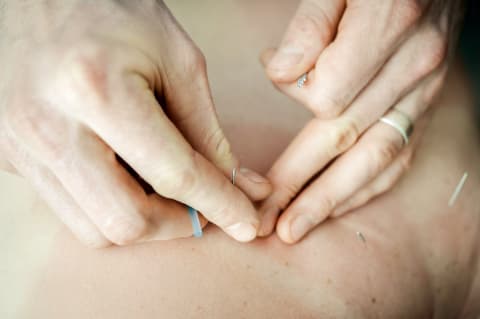The goal of dry needling is to induce a spasm in the muscle, which releases the trigger point and allows the knot in the muscle to relax. Sound a little painful? It definitely can be. Poking needles in your muscles is no walk in the park, but dry needling can be very effective at targeting deeper areas that can’t reached by other manual therapies like massage. People swear by dry needling’s ability to relax muscles and reduce pain in a way that can’t seem to be achieved any other way. Numerous other studies have confirmed its effectiveness at treating acute and chronic pain and shown it to be a relatively simple, noninvasive, and low-risk method (assuming it’s done correctly and by someone well-trained). Knowing this, it’s hard to understand why dry needling isn’t very well-known. According to Marvin Singh, a triple board-certified physician, “A recent study demonstrated that including dry needling into a rehabilitation program2 could decrease spasticity and improve balance and range of motion in those who have had a stroke.” Therefore, while it seems that dry needling could potentially play a role in myofascial and other muscular pain syndromes, the quality of the studies that have been done is not great enough to draw any definitive conclusions. And on that note: Both Dr. Singh and Dr. Kalika recommend UGDN whenever possible. The potential risks are significantly reduced if you use an ultrasound as Dr. Kalika does in his practice at New York Dynamic Neuromuscular Rehabilitation and Physical Therapy. So what should you look for in a dry needling practitioner besides that they use UGDN? Dr. Kalika says that you should look for a professional who has a dry needling certification and preferably other certifications in manual therapy methods—like myofascial release approach and joint mobilization certifications as well. According to Dr. Kalika, this is because having skill in palpation and examination of soft tissue is also necessary to have real success with dry needling. And that makes sense: You want someone who has an intricate knowledge of human anatomy and physiology to increase the chances that they’ll be able to target the trigger points as efficiently as possible. So why, then, is it so controversial? Despite cost and safety concerns from going to a practitioner that isn’t properly trained, dry needling is a symptom of the battle between conventional and alternative medicine techniques. Dr. Kalika had some important final thoughts on the controversy surrounding dry needling: “I think there are two reasons, 1) We cannot yet find the exact mechanism of action. 2) Dry needling is a time-consuming and not an easily learned skill. There is big resistance from the medical community because doctors and specialists look for quick, invasive, and more profitable solutions. There is also pushback on this procedure because no medicine is injected during the procedure, so there is no gain to the pharmaceutical industry either.” So is dry needling right for you? It’s not without risks, and it’s not for the faint of heart—since it can cause significant pain when the muscle is releasing—but if you have low-back pain, mid-back pain, neck pain, shoulder pain, sciatica, carpal tunnel, plantar fasciitis, or frequent headaches and hip pain that doesn’t seem to be responding to other treatments, it’s definitely worth considering.




